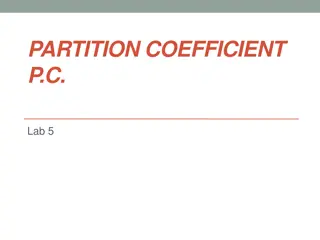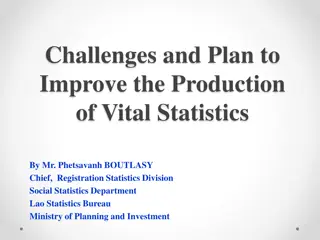Understanding Partition Values in Statistics
Partition values such as quartiles, deciles, and percentiles play a crucial role in dividing a dataset into various segments for analysis. Quartiles split the data into 4 equal parts, deciles into 10 parts, and percentiles into 100 parts. These values help in understanding the distribution of data and identifying key points within the dataset, such as medians and other key percentiles.
Download Presentation

Please find below an Image/Link to download the presentation.
The content on the website is provided AS IS for your information and personal use only. It may not be sold, licensed, or shared on other websites without obtaining consent from the author. Download presentation by click this link. If you encounter any issues during the download, it is possible that the publisher has removed the file from their server.
E N D
Presentation Transcript
Partition Values: Quartiles, Deciles and Percentiles Just as median divides the total number of observations into two equal parts, there are similar other measures which are used to divide, or partition, the observations into a fixed number of parts, say 4, 10 or 100. These are collectively knowns as partition values or quantiles or fractiles. Some of the important types of partition values are, (a) Median, (b) Quartiles, (c) Deciles, (d) Percentiles.
Median We know that median is the middle-most value of a set of observations, i.e. it divides the total number of observations into 2 equal parts. The number of observations smaller than median is the same as the number larger than it. For data of continuous type, exactly one-half of the observations are smaller than median, i.e., median is the value of the variable corresponding to cumulative frequency N/2. These ideas are extended to Quartiles, Deciles and Percentiles.
Quartiles Quartiles are such values which divide the total number of observations into 4 equal parts. Obviously, there are 3 quartiles - 1. First Quartile (or Lower Quartile): Q1 2. Second Quartile, (or Middle Quartile): Q2 3. Third Quartile (or Upper Quartile): Q3 For data of continuous type, one-quarter of the observations is smaller than Q1, two-quarters are smaller than Q2 and three-quarters are smaller than Q3. This means that Q1, Q2, Q3 are values of the variables corresponding to less-than cumulative frequencies N/4, 2N/4, 3N/4 respectively. Since, 2N/4=N/2, it is evident that the second quartile Q2 is the same as median.
Deciles Deciles are such values which divide the total number of observations into 10 equal parts. There are 9 deciles, D1, D2 .D9 called the first decile, the second decile, etc. The number of observations smaller than D1, or between two successive deciles, or larger than D9 is the same. For data of continuous type D1, D2..,D9 correspond to cumulative frequencies N/10, 2N/10, 9N/10 respectively.
Percentiles Percentiles are such values which divide the total number of observations into 100 equal parts. There are 99 percentiles P1, P2, P99, called the first percentile, the second percentile, and so on. The k-th percentile (Pk) is, therefore, that value of the variable upto which lie exactly k % of the total number of observations. Hence, Pk corresponds to less-than cumulative frequency kN/100.
Calculation of Partition Values The method of calculation of quartiles, deciles, percentiles is exactly the same as that employed for median using interpolation in a cumulative frequency distribution. These may also be obtained graphically from ogive. For example, the 7thdecile D7 is the abscissa of that point on the ogive whose coordinate is 7N/10.























